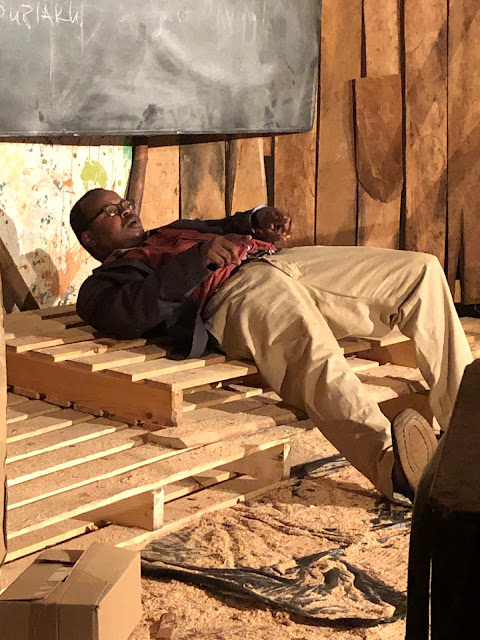By Margaretta wa Gacheru (posted 23 September 2019)
How often have Kenyan artists had
their expectations lifted high in the hope that they’d at last be taken
seriously and would get their own National Art Gallery?
They had seen other countries
recognize the importance of the arts by creating a national institution that
celebrated their creativity, individuality and even their national identities.
African countries like South Africa, Namibia, Senegal and Benin (among others)
all have national art institutions that recognize the positive role that the
arts, culture and creative expression play in contributing to both a sense of national
identity and those countries’ GNP.
Even countries in the Middle East and
Asia (like Jordan, Indonesia, Malaysia, India and even Bangladesh) have
national galleries as do most countries in Europe and US.
But despite the creation of a
National Art Gallery having been a topic of conversation since the dawn of
Independence, the talk has never borne fruit.
The closest that Kenyan artists came
to having their own National Gallery was in the late 1970s when the plan was to
convert the former Bank of India into the Gallery. But then, the funds for the
project disappeared mysteriously and the whole plan dissolved, salvaged only slightly
when that space was turned not into a Gallery but into the National Archives.
But this past week, a glimmer of hope
appeared on the horizon when Nairobi National Museum called a wide range of
so-called ‘stake holders’ to discuss the notion of developing a National Art
Gallery of Kenya (or NAGOK).
And while the Guest of Honor, the Cabinet
Secretary for Culture, the Arts and Sports, Ambassador Dr Amina Mohammed wasn’t
able to attend the opening ceremony, her representative, Mr Hassan Noor assured
the gathering that Dr Amina has already begun raising seed capital for the
Gallery. What’s more, he said she is committed to establishing a ‘world-class’
National Art Gallery before she leaves office.
This could be a challenge since the
Chairman of the Board of the National Museum, Tony Wainaina suggested the time
frame for completing the National Art Gallery could be between four and five
years.
Nonetheless, the mood among nearly
all the stakeholders present at the workshop was upbeat and hopeful. That
included a number of the artists, private collectors and gallerists
representing spaces like One Off, Circle Art, Banana Hill, Kenyatta University,
Ngeche Artists, Wildebeeste Workshop, Kenya Museum Society, Samosa Festival,
Kenya National Visual Artists Association and the Museum itself.
What’s more, artists came all the way
from Maseno, Naivasha, Kisii and Lamu to participate in the workshop, thus
reflecting the Museum’s commitment to opening up artists’ participation in the
process of building NAGOK.
As a way of obtaining stakeholders’
input in the process, another Museum Board member, Kibachia Gatu organized four
working groups, each with a separate topic to discuss.
The topics included artists’
participation in the NAGOK process, sustainability and the role of the arts in Kenya’s
economic and social development, NAGOK’s relationship to other art
institutions, be they local, regional or international, and finally, the scope
of NAGOK’s cultural space.
To ensure that all the stakeholders
were ‘on the same page’, Lydia Galavu, curator at the Museum’s Creativity
Gallery gave a brief historical overview of the visual arts in Kenya. She
traced it back to Makerere University’s Margaret Trowell School of Art which
East African artists attended. Among them were Kenyans like Gregory Maloba,
Louis Mwanyiki, Rosemary Karuga and Asaph Ng’ethe. Then came Chemi Chemi and
Paa ya Paa which Elimo Njau co-founded with Pheroze Norowjee, Hilary Ng’weno,
Jonathan Kariara and Terry Hirst among others. There were several commercial
galleries that came and went, but in the 1980s, Sisi kwa Sisi (represented by
Zarina Patel and Etale Sukuro) launched a movement to bring art to the people.
Subsequently, the art scene has grown exponentially, both in terms of artists’
collectives being established and commercial galleries like One Off, Circle
Arts and others coming into being.
Nonetheless, the visual arts
community in Kenya has never been a cohesive body. Nor has it had strong
government support up until now when it would seem the Kenya Government is
prepared to get behind NAGOK.
Speaking to the group at mid-day,
Kenyan industrialist and philanthropist Manu Chandaria also noted that now is
the first time the government has expressed an interest in the [visual] arts.
“Let us push this initiative as much as we can,” he said. ‘No museum [and
possibly no country] can survive without a national art gallery,” he added.

































